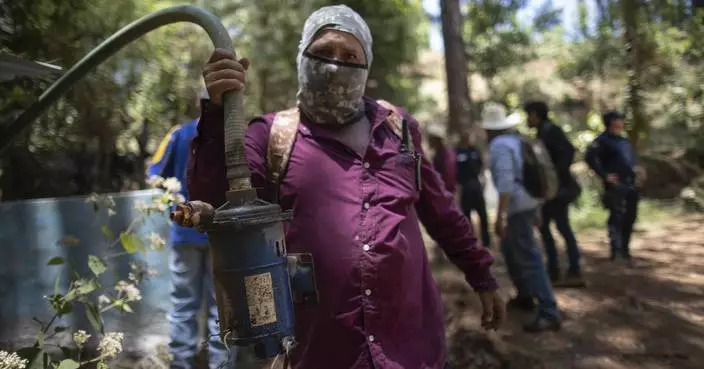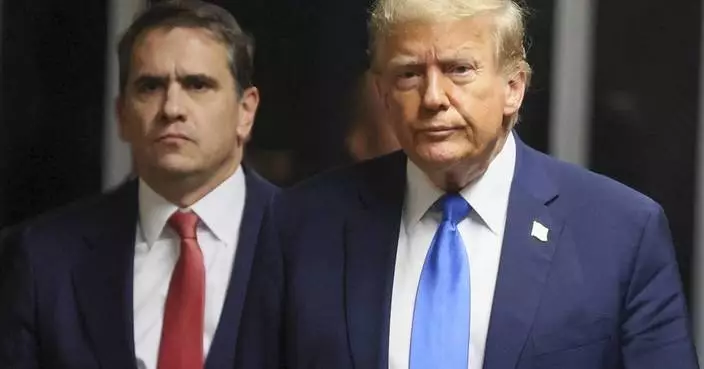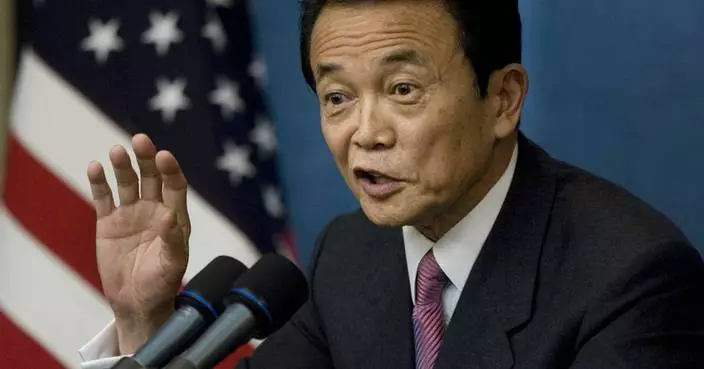The United States attacked first, imposing tariffs on steel and aluminum from around the globe and threatening to hit tens of billions of dollars in Chinese products.

FILE - In this Sept. 12, 2017 file photo Daimler CEO Dieter Zetsche speaks at a Mercedes press conference on the first media day of the International Frankfurt Motor Show IAA in Frankfurt, Germany. (AP Photo/Michael Probst, file )
Now, the world is punching back.
The European Union is set Friday to slap tariffs on $3.4 billion in American products, from whiskey and motorcycles to peanuts and cranberries. India and Turkey have already targeted U.S. products, ranging from rice to autos to sunscreen.
And the highest-stakes fight still looms: In two weeks, the United States is to start taxing $34 billion in Chinese goods. Beijing has vowed to immediately retaliate with its own tariffs on U.S. soybeans and other farm products in a direct shot at President Donald Trump's supporters in America's heartland.
The tit-for-tat conflict between the United States and China — the world's two largest economies — is poised to escalate from there. The rhetoric is already intensifying.
"We oppose the act of extreme pressure and blackmail by swinging the big stick of trade protectionism," a spokesman for China's Commerce Ministry said Thursday. "The U.S. is abusing the tariff methods and starting trade wars all around the world."
Cecilia Malmstrom, the EU's trade commissioner, acknowledged that the EU had targeted some iconic American imports for tariffs, like Harley-Davidson motorcycles and bourbon, to "make noise" and put pressure on U.S. leaders.
John Murphy, a senior vice president at the U.S. Chamber of Commerce, estimates that $75 billion in U.S. products will be subject to new foreign tariffs by the end of the first week of July.
"We've never seen anything like this," said Mary Lovely, a Syracuse University economist who studies international trade — at least not since countries tried to wall themselves off from foreign competition during the Great Depression.
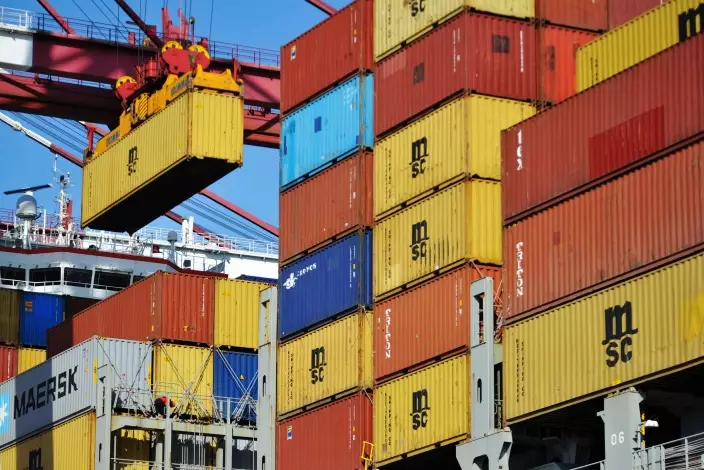
FILE - In this April 8, 2018 file photo,a container is loaded onto a cargo ship at a port in Qingdao in east China's Shandong province, Sunday, April 8, 2018. (Chinatopix via AP)
Those personally in the line of fire are among the most concerned.
"It will be a disaster," said Nagesh Balusu, manager of the Salt Whisky Bar and Dining Room in London and expects the European Union's tariffs to add more than $7 to the price of a bottle of Jack Daniels, which is imported from Tennessee. "It's going to hit customers, that's for sure. How they'll take it, we'll have to wait and see."
As painful as the brewing trade war could prove, many have seen it coming.
Trump ran for the presidency on a vow to topple seven decades of American policy that had favored ever-freer trade among nations. He charged that a succession of poorly negotiated accords — including the North American Free Trade Agreement and the pact that admitted China into the World Trade Organization — put American manufacturers at an unfair disadvantage and destroyed millions of U.S. factory jobs.
He pledged to impose tariffs on imports from countries that Trump said had exploited the United States. Late last month, Trump proceeded to infuriate U.S. allies — from the EU to Canada and Mexico by imposing tariffs of 25 percent on imported steel and 10 percent on aluminum. The president justified the move by saying imported metals threatened America's national security — a dubious justification that countries have used rarely because it can be so easily abused.
And he is threatening to impose another national security-based tariff on imports of cars, trucks and auto parts.
Trump has also started a trade fight with China over Beijing's sharp-elbowed efforts to overtake U.S. technological dominance. China's tactics range from forcing American companies to hand over technology in exchange for access to the Chinese market to outright cyber-theft.
The White House last week announced plans to slap 25 percent tariffs on 1,100 Chinese goods, worth $50 billion in imports. Trump would start July 6 by taxing $34 billion worth of products and later add tariffs on an additional $16 billion in goods.
The Chinese have said they will respond in kind. Trump said he would then retaliate against any counterpunch from Beijing by targeting an additional $200 billion in Chinese products, and then yet another $200 billion if China refused to back down. All told, the $450 billion in potential tariffs would cover nearly 90 percent of goods China sends to the United States.
The tariffs and threats have begun to take a toll. Steel and aluminum prices, for example, have shot up and supplies have become scarce.
"Steel pricing is usually relatively stable," said Al Rheinnecker, CEO of American Piping Products in Chesterfield, Missouri, which distributes steel pipe to numerous industries. But "since April, you can quote something on Monday, and if the customer doesn't buy it right away, you may have to raise the price on Thursday."
So far, Rheinnecker has managed to pass along the higher costs to his customers. He's not sure how long that will last.
The Commerce Department is allowing companies to request exemptions from the steel and aluminum tariffs — if they can show that the metals they need aren't available from Americans producers. The department expected 4,500 requests. But it's been overwhelmed by more than 20,000. This week, it said it has processed just 98 requests so far, approving 42 and denying 56.
The rising tensions and the chaos surrounding the steel and aluminum tariffs are starting to generate pushback on Capitol Hill. Senators this week grilled Commerce Secretary Wilbur Ross.
"As you consider these tariffs, know that you are taxing American families, you are putting American jobs at risk, and you are destroying markets — both foreign and domestic — for American businesses of all types, sorts and sizes," said Senate Finance Chairman Orrin Hatch, R-Utah.
Economists and trade analysts worry that there may be no way out of an all-out trade war between the United States and its most vital trading partners.
"The president has been so belligerent that it becomes almost impossible for democratically elected leaders — or even a non-democratic leader like (Chinese president) Xi Jinping — to appear to kowtow and give in," said Philip Levy, senior fellow at the Chicago Council on Global Affairs and a former White House trade adviser. "The president has made it very hard for other countries to give him what he wants."
KYIV, Ukraine (AP) — A big, new package of U.S. military aid will help Ukraine avoid defeat in its war with Russia. Winning will still be a long slog.
The arms and ammunition in the $61 billion military aid package should enable Ukraine to slow the Russian army's bloody advances and block its strikes on troops and civilians. And it will buy Ukraine time — for long-term planning about how to take back the fifth of the country now under Russian control.
“Ultimately it offers Ukraine the prospect of staying in the war this year,” said Michael Clarke, visiting professor in war studies at King’s College London. “Sometimes in warfare you’ve just got to stay in it. You’ve just got to avoid being rolled over.”
The U.S. House of Representatives approved the package on Saturday after months of delays by some Republicans wary of U.S. involvement overseas. It was passed by the Senate on Tuesday, and President Joe Bidensigned it into law on Wednesday.
The difference could be felt within days on the front line in eastern and southern Ukraine, where Russia’s much larger army has been slowly taking territory against massively outgunned Ukrainian forces.
The aid approval means Ukraine may be able to release artillery ammunition from dwindling stocks that it has been rationing. More equipment will come soon from American stocks in Poland and Germany, and later from the U.S.
The first shipments are expected to arrive by the beginning of next week, said Davyd Arakhamia, a lawmaker with Ukrainian President Volodymyr Zelenskyy’s Servant of the People party.
But opposition lawmaker Vadym Ivchenko, a member of the Ukrainian parliament’s National Security, Defense and Intelligence Committee, said logistical challenges and bureaucracy could delay shipments to Ukraine by two to three months, and it would be even longer before they reach the front line.
While details of the shipments are classified, Ukraine’s most urgent needs are artillery shells to stop Russian troops from advancing, and anti-aircraft missiles to protect people and infrastructure from missiles, drones and bombs.
What’s coming first is not always what front-line commanders need most, said Arakhamia, the Ukrainian lawmaker. He said that even a military giant like the U.S. does not have stockpiles of everything.
“The logic behind this first package was, you (the U.S.) finds our top priorities and then you see what you have in the warehouses,” Arakhamia said. “And sometimes they do not match.”
Hope for future breakthroughs for Ukraine still hangs on more timely deliveries of Western aid, lawmakers acknowledge.
Many experts believe that both Ukraine and Russia are exhausted by two years of war and won’t be able to mount a major offensive — one capable of making big strategic gains — until next year.
Still, Russia is pushing forward at several points along the 1,000-kilometer (600-mile) front, using tanks, wave after wave of infantry troops and satellite-guided gliding bombs to pummel Ukrainian forces. Russia is also hitting power plants and pounding Ukraine’s second-largest city, Kharkiv, which is only about 30 kilometers (some 20 miles) from the Russian border.
Ivchenko said the goal for Ukraine’s forces now is to “hold the line” until the bulk of new supplies arrive by mid-summer. Then, they can focus on trying to recapture territory recently lost in the Donetsk region.
“And probably ... at the end of summer we’ll see some movement, offensive movement of the Ukrainian armed forces,” he said.
Some military experts doubt Ukraine has the resources to mount even small offensives very soon.
The U.S. funding “can probably only help stabilize the Ukrainian position for this year and begin preparations for operations in 2025,” said Matthew Savill, director of military sciences at the Royal United Services Institute, a think tank.
In the best-case scenario for Ukraine, the American aid will give commanders time to reorganize and train its army — applying lessons learned from its failed summer 2023 offensive. It may also galvanize Ukraine’s allies in Europe to increase aid.
“So this just wasn’t about Ukraine and the United States, this really affected our entire 51-country coalition,” said U.S. Congressman Bill Keating, a Democrat who visited Kyiv on Monday as part of a four-member congressional delegation.
Zelenskyy insists Ukraine's war aim is to recapture all its territory from Russia — including Crimea, seized illegally in 2014. Even if the war ultimately ends through negotiation, as many experts believe, Ukraine wants to do that from as strong a position as possible.
Whatever happens on the battlefield, Ukraine still faces variables beyond its control.
Former U.S. President Donald Trump, who seeks to retake the White House in the November election, has said he would end the war within days of taking office. And the 27-nation Europe Union includes leaders like Hungarian Prime Minister Viktor Orbán and Slovak Prime Minister Robert Fico, who have opposed arming Ukraine.
Ukraine’s allies have held back from supplying some arms out of concern about escalation or depleting their own stocks. Ukraine says that to win the war it needs longer-range missiles it could use for potentially game-changing operations such as cutting off occupied Crimea, where's Russia's Black Sea fleet is based.
It wants a longer-range version of Army Tactical Missile Systems, known as ATACMs, from the U.S. and Taurus cruise missiles from Germany. Both governments have resisted calls to send them because they are capable of striking targets deep within Russian territory.
The new bill authorizes the president to send Ukraine the longer-range ATACMS, which have a range of some 300 kilometers (190 miles), “as soon as practicable.” It's unclear what that will mean in practice.
Sometimes, promised weapons have arrived late, or not at all. Zelenskyy recently pointed out that Ukraine is still waiting for the F-16 fighter jets it was promised a year ago.
Meanwhile, Russia is using its advantage in troops and weapons to push back Ukrainian forces, perhaps seeking to make maximum gains before Ukraine's new supplies arrive.
For weeks it has pummeled the small eastern city of Chasiv Yar, suffering heavy losses. Britain's Ministry of Defense says 900 Russian troops are being killed or injured a day in the war.
Capturing the strategically important hill town would allow them to move toward Sloviansk and Kramatorsk, key cities Ukraine controls in the eastern region of Donetsk. It would be a significant win for Russian President Vladimir Putin, who Western officials say is bent on toppling Ukraine’s pro-Western government.
Russian pressure was aimed not just at gaining territory, but on undermining Zelenskyy and bolstering critics who say his war plan is failing, said Clarke of King's College London.
The U.S. aid package decreases the likelihood of a political crisis in Ukraine, and U.S. Speaker Mike Johnson deserves credit for pushing it through Congress, he said.
"He held history in his hands,” Clarke said.
This story has been updated to correct Orbán's title, the Slovak prime minister's name and that the British estimate of daily Russian losses is for the war, not one battle.
Follow AP’s coverage of the war in Ukraine at https://apnews.com/hub/russia-ukraine

From left, U.S. representatives Nathaniel Moran, R-Tx, Tom Kean Jr, R-NJ, Bill Keating, D-Mass, and Madeleine Deane, D-Pa, talk to journalists during a joint news conference outside Saint Michael cathedral in Kyiv, Ukraine, Monday, April 22, 2024. A newly approved package of $61 billion in U.S. aid may prevent Ukraine from losing its war against Russia. But winning it will be a long slog. (AP Photo/Francisco Seco)

A volunteer makes a camouflage net at a facility producing material for Ukrainian soldiers in Kyiv, Ukraine, Monday, April 22, 2024. A newly approved package of $61 billion in U.S. aid may prevent Ukraine from losing its war against Russia. But winning it will be a long slog. (AP Photo/Francisco Seco)
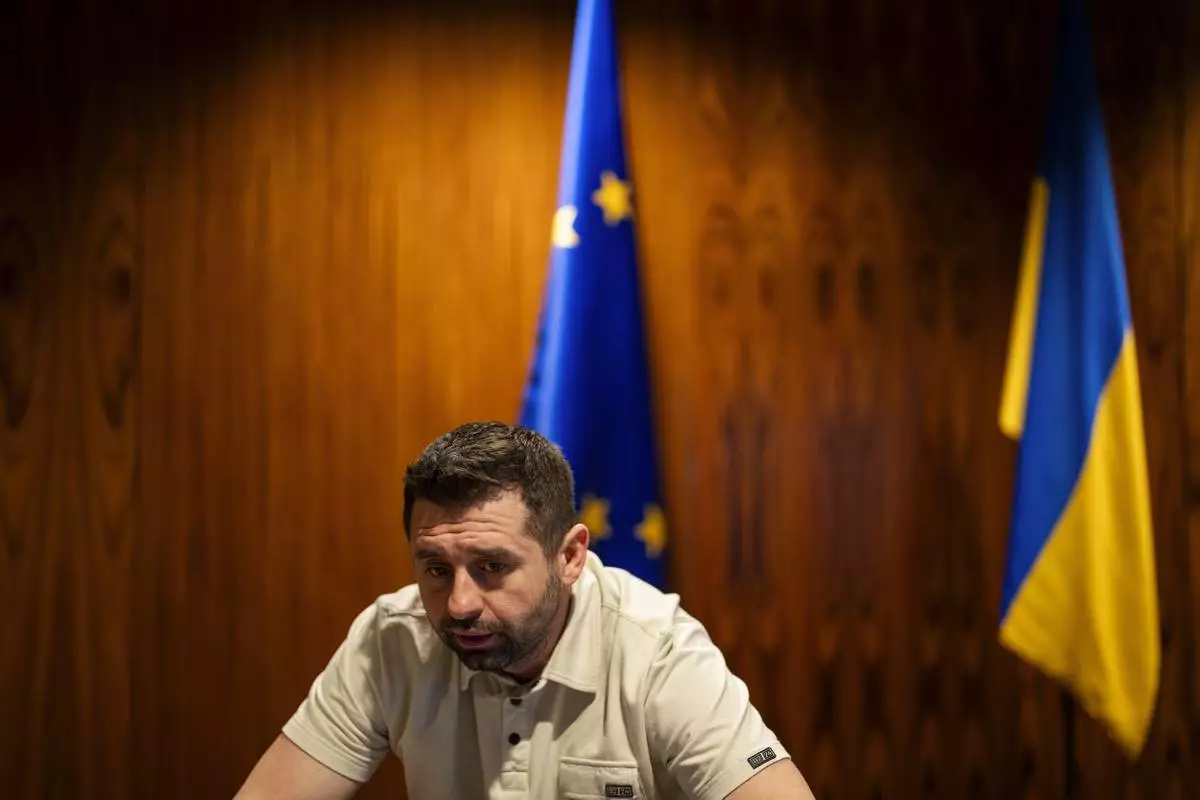
Davyd Arakhamia, a lawmaker with Ukrainian President Volodymyr Zelenskyy's Servant of the People party, talks during an interview with Associated Press in Kyiv, Ukraine, Monday, April 22, 2024. (AP Photo/Francisco Seco)

A woman rallies to raise awareness on the fate of Ukrainian prisoners of war in Kyiv, Ukraine, Sunday, April 21, 2024. (AP Photo/Francisco Seco)
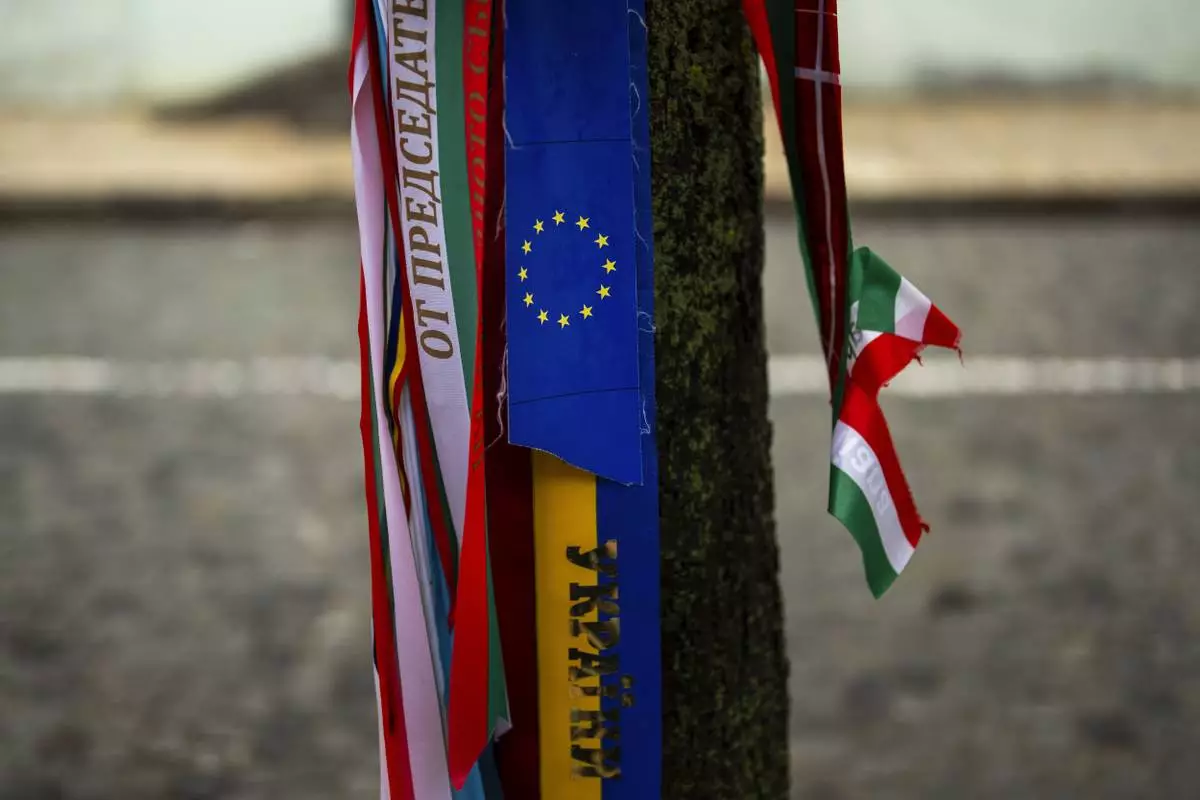
Ribbons with the colors of the European Union and Ukraine are attached to a tree next to memorial wall of Ukrainian soldiers killed during the war in Kyiv, Ukraine, Monday, April 22, 2024. (AP Photo/Francisco Seco)
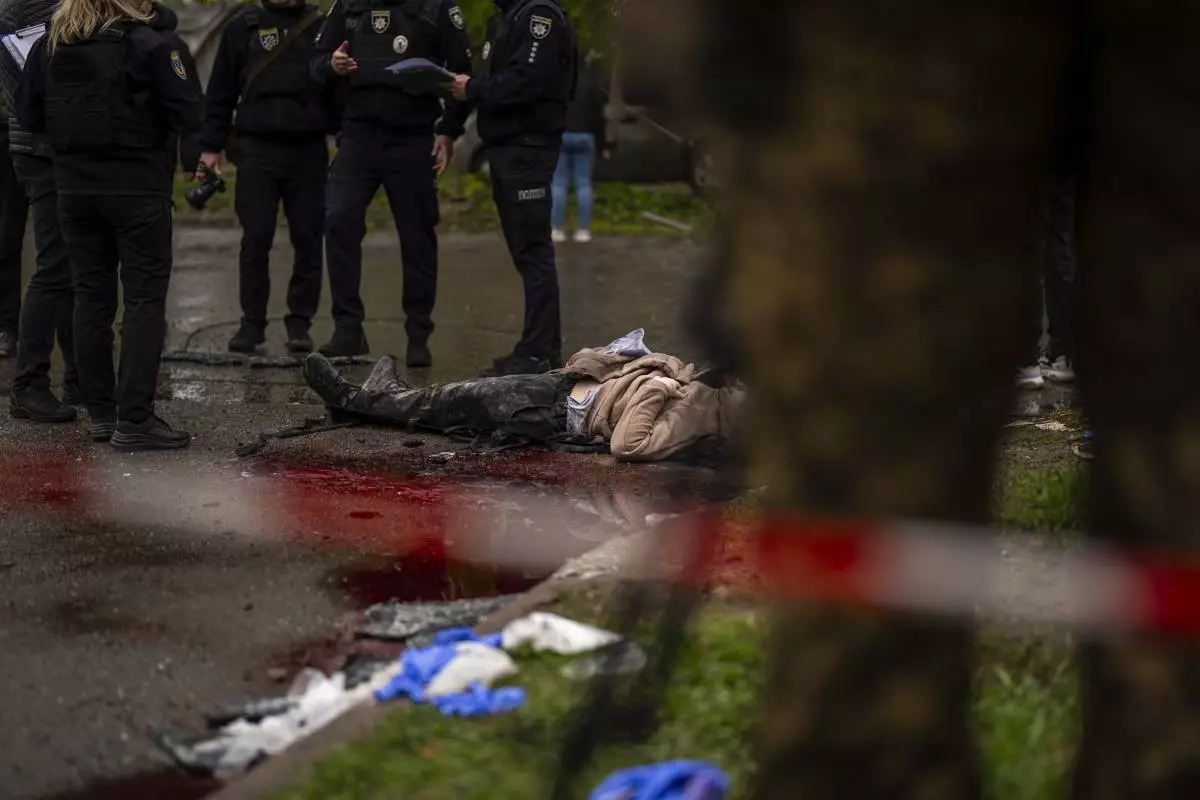
The body of a woman killed by Russian bombardment in Chernihiv, Ukraine, Wednesday, April 17, 2024. (AP Photo/Francisco Seco)

Soldiers carry the coffins of two Ukrainian army sergeants during their funeral in Lviv, Ukraine, Tuesday, April 16, 2024. (AP Photo/Francisco Seco)














